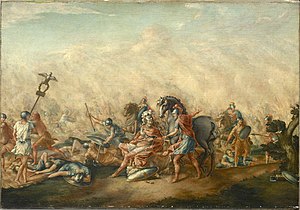
Back Slag van Cannae Afrikaans Cannae Beadu ANG معركة كاناي Arabic Batalla de Cannas AST Kanna döyüşü Azerbaijani کانا دؤیوشو AZB Битка при Кана Bulgarian Emgann Cannae Breton Bitka kod Kane BS Batalla de Cannes Catalan
| Battle of Cannae | |||||||||
|---|---|---|---|---|---|---|---|---|---|
| Part of the Second Punic War | |||||||||
 John Trumbull, The Death of Paulus Aemilius at the Battle of Cannae (1773) | |||||||||
| |||||||||
| Belligerents | |||||||||
| Roman Republic | Carthage | ||||||||
| Commanders and leaders | |||||||||
| Strength | |||||||||
Total: 86,400
|
Total: 50,000
| ||||||||
| Casualties and losses | |||||||||
| Total: 67,500–80,000 | Total: 5,700–8,000 | ||||||||
Location of the battle within Italy | |||||||||
The Battle of Cannae (/ˈkæni, -eɪ, -aɪ/;[c] Latin: [ˈkanːae̯]) was a key engagement of the Second Punic War between the Roman Republic and Carthage, fought on 2 August 216 BC near the ancient village of Cannae in Apulia, southeast Italy. The Carthaginians and their allies, led by Hannibal, surrounded and practically annihilated a larger Roman and Italian army under the consuls Lucius Aemilius Paullus and Gaius Terentius Varro. It is regarded as one of the greatest tactical feats in military history and one of the worst defeats in Roman history, and it cemented Hannibal's reputation as one of antiquity's greatest tacticians.
Having recovered from their losses at Trebia (218 BC) and Lake Trasimene (217 BC), the Romans decided to engage Hannibal at Cannae, with approximately 86,000 Roman and allied socii troops. They massed their heavy infantry in a deeper formation than usual, while Hannibal used the double envelopment tactic and surrounded his enemy, trapping the majority of the Roman army, who were then slaughtered. The loss of life on the Roman side meant it was one of the most lethal single days of fighting in history; Adrian Goldsworthy equates the death toll at Cannae to "the massed slaughter of the British Army on the first day of the Somme offensive in 1916".[5] Only about 15,000 Romans, most of whom were from the garrisons of the camps and had not taken part in the battle, escaped death. Following the defeat, Capua and several other Italian city-states defected from the Roman Republic to Carthage.
As news of this defeat reached Rome, the city was gripped in panic. Authorities resorted to extraordinary measures, which included consulting the Sibylline Books, dispatching a delegation led by Quintus Fabius Pictor to consult the Delphic oracle in Greece, and burying four people alive as a sacrifice to their gods. To raise two new legions, the authorities lowered the draft age and enlisted criminals, debtors and even slaves. Despite the extreme loss of men and equipment, and a second massive defeat later that same year at Silva Litana, the Romans refused to surrender to Hannibal. His offer to ransom survivors was brusquely refused. The Romans fought for 14 more years until they achieved victory at the Battle of Zama.
Cite error: There are <ref group=lower-alpha> tags or {{efn}} templates on this page, but the references will not show without a {{reflist|group=lower-alpha}} template or {{notelist}} template (see the help page).
- ^ "Slaughter at the Battle of Cannae". Warfare History Network. Retrieved 2023-09-06.[better source needed]
- ^ Plutarch 1916, 16.8.
- ^ Delbrück 1975, pp. 320, 327.
- ^ Goldsworthy 2001, p. 194.
- ^ Goldsworthy 2001, p. 159.
